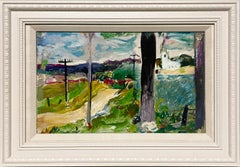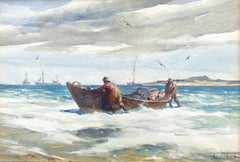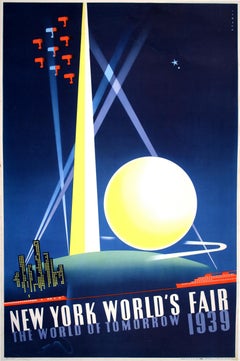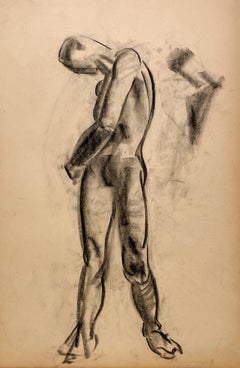1930s Art
to
1,011
3,389
1,187
901
524
338
Overall Width
to
Overall Height
to
7,505
21,271
158,415
232,683
1,962
2,230
4,875
6,387
5,805
13,238
19,592
25,593
18,211
13,522
5,367
2,451
483
375
227
131
113
104
71
12
12
5
2
2
3,494
2,381
312
3,823
1,719
1,613
1,138
1,095
707
452
440
437
364
356
317
288
285
274
253
225
218
211
193
2,010
1,529
1,354
1,156
858
261
105
87
83
61
1,742
1,139
3,316
2,662
Period: 1930s
The Rabbit and The Cat
Located in Cotignac, FR
Pair of drawings on paper of a rabbit and a cat by Margaret Lisel. They are both signed bottom right and dated for 1934. The drawings are presented as a pair in plain gilt frames.
A...
Category
Romantic 1930s Art
Materials
Crayon, Pencil
A Cheerful, 1930s American Scene Landscape Painting, "Country Road"
Located in Chicago, IL
A Cheerful, 1930s American Scene Landscape Painting of Country Road by Notable Chicago Modern Artist, Francis Chapin (Am. 1899-1965). A gem of a painting, exemplifying Chapin's stea...
Category
American Modern 1930s Art
Materials
Oil, Masonite
“The Lobstermen”
By Gordon Grant
Located in Southampton, NY
Beautiful original watercolor and gouache on archival paper by the famous American marine artist, Gordon Grant. The artwork depicts two rugged lobstermen bringing their catch ashore...
Category
American Realist 1930s Art
Materials
Watercolor, Gouache, Archival Paper
Original Vintage New York World's Fair 1939 Poster by Joseph Binder Medium Forma
Located in Boca Raton, FL
This poster, by Joseph Binder for the 1939 World’s Fair Poster features in the centermost portion of the image, the Trylon and the Persisphere,...
Category
1930s Art
Materials
Lithograph
Charles PICART LE DOUX, The Beautiful Girl, Oil on Canvas, 1939
Located in Saint Amans des cots, FR
Oil on canvas by Charles PICART LE DOUX (1881-1959), France, 1939. The Beautiful Girl. With frame: 85.5x72.5 cm - 33.7x28.5 inches ; without frame: 73x60cm - 28.75x23.6 inches. 20F f...
Category
Post-Impressionist 1930s Art
Materials
Canvas, Oil
A Fine, Modern 1930s Academic Anatomical Figure Study (Standing Male Nude Model)
Located in Chicago, IL
A Fine 1930s, Modern Academic Figure Study Drawing of a Standing Male Nude Model by Notable Chicago Artist, Harold Haydon (Am. 1909-1994). An exceptionally well executed, early 1930...
Category
American Modern 1930s Art
Materials
Paper, Charcoal
A Fine, Modern 1930s Academic Anatomical Figure Study (Standing Male Nude Model)
Located in Chicago, IL
A Fine 1930s, Modern Academic Figure Study Drawing of a Standing Male Nude Model by Notable Chicago Artist, Harold Haydon (Am. 1909-1994). An exceptionally well executed, early 1930...
Category
American Modern 1930s Art
Materials
Paper, Charcoal
New England Town Scene Oil Painting by listed artist Emile Gruppe (1896-1978)
Located in Baltimore, MD
Emile Albert Gruppe was a very well known Cape Ann, Massachusetts painter who founded his own Gruppe Summer School in 1942. He was born in Rochester, NY in 1896 and studied at the A...
Category
Post-Impressionist 1930s Art
Materials
Oil
$5,440 Sale Price
20% Off
A Fine 1930s, Modern Academic Figure Study Drawing of a Standing Male Nude Model
Located in Chicago, IL
A Fine 1930s, Modern Academic Figure Study Drawing of a Standing Male Nude Model by Notable Chicago Artist, Harold Haydon (Am. 1909-1994). An exceptionally well executed, early 1930...
Category
American Modern 1930s Art
Materials
Paper, Charcoal
'Diver' — 1930s American Modernism
Located in Myrtle Beach, SC
Rockwell Kent, 'Diver', wood engraving, 1931, edition 150, Burne Jones 88. Signed, and titled 'The Diver' in pencil.. A brilliant, black impression, on cream, wove Japan paper; the f...
Category
American Modern 1930s Art
Materials
Woodcut
Norman Parkinson 'For ballerinas on the beach and in the swim, 1939'
Located in New York, NY
Fashion model Pamela Minchin photographed on the Isle of Wight wearing Fortnum and Mason’s dark burgundy Lastex satin swimsuit with ballet skirt, Harper’s Bazaar, July 1939.
'For ba...
Category
Modern 1930s Art
Materials
Silver Gelatin
Man on Horseback Sculpture
Located in Douglas Manor, NY
#9-031 Man on horseback , 1930's figurative sculpture,finely detailed metal casting .
Category
1930s Art
Materials
Metal
Thames Divers (1934) - Silver Gelatin Fibre Print
Located in London, GB
Thames Divers (1934) - Silver Gelatin Fibre Print
(Photo by H F Davis/Getty Images Archive)
Two divers jumping off the Embankment into the River Thames in London, near Westminster...
Category
Modern 1930s Art
Materials
Black and White, Silver Gelatin
Downtown New York
Located in Los Angeles, CA
Downtown New York, c. 1930s, oil on canvas, signed lower right, 10 x 12 inches; label verso reads: "Harry Dix / Title Downtown New York / Medium Oil"
Harry Dix was a 20th-century p...
Category
American Modern 1930s Art
Materials
Canvas, Oil
Erotic - Drawing by Maurice Vertès - 1930s
Located in Roma, IT
Erotic is an original pencil drawing realized by Maurice Vertès in 1930s.
The little drawing is in good condition on a yellowed paper.
On the back the stamp of the collection by Comtesse Anna Laetitia...
Category
Modern 1930s Art
Materials
Pencil
Frida Painting "Two Fridas" - Black and White Photograph, Portrait, Frida Kahlo
Located in Denton, TX
Frida Painting "Two Fridas" by Nickolas Muray is a limited edition black and white portrait of Mexican painter Frida Kahlo in her studio, sitting in front of her famous painting, The...
Category
Modern 1930s Art
Materials
Archival Pigment
Winter Water, Large Seascape of Point Lobos, Monterey, California Shore
Located in Beachwood, OH
Ferdinand Burgdorff (American, 1881-1975)
Winter Water, c. 1930
Oil on masonite
Signed lower left, titled verso
40 x 46 inches
43 x 49.25 inches, framed
Written Verso: Along the Pac...
Category
1930s Art
Materials
Oil
Flower Still Life
By Adrian Dornbush
Located in Los Angeles, CA
(Note: This work is part of our exhibition Connected by Creativity: WPA Era Works from the Collection of Leata and Edward Beatty Rowan)
Oil on canvas, 24 ½ x 19 ½ inches unframed, 32 x 27 inches framed, signed and inscribed “Adrian Dornbush/ Flower Still Life” verso, a remnant of exhibition label verso, stamped “1454” verso, original frame
Exhibited:
i) Midwestern Artist’s Exhibition Representative Work from Missouri, Kansas, Oklahoma, Nebraska & Colorado, Kansas City Art Institute, February 1 to March 2, 1931, no. 34 (see catalog with a listing of work with this title); and ii) Special Display and Sale of Late Oil Paintings Produced by Cedar Rapids Own Artists from the Little Gallery, at Newman’s Department Store, Cedar Rapids, Iowa, March 1932 (see [Advertisement], The Gazette (Cedar Rapids, Iowa), March 15, 1932 – listing a work with this title, together with paintings by fourteen other artists, including Grant Wood, Marvin Cone...
Category
American Modern 1930s Art
Materials
Oil
Antique American Modernist Framed Flower Fauvist Still Life Signed Oil Painting
Located in Buffalo, NY
Impressive early American modernist flower still life oil painting. Framed. Oil on canvas. Signed. Image size, 12H by 10L.
Category
Modern 1930s Art
Materials
Canvas, Oil
Toadstool - Woodcut by Maurits Cornelis Escher - 1931
Located in Roma, IT
Woodcut print realized by Escher in 1931.
It belongs to the series "Emblemata".
Monogrammed in the plate lower left.
Excellent condition.
Ref. F.H. Bool, J.R. Kist, J.L. Locher a...
Category
Modern 1930s Art
Materials
Woodcut
A Fine, Modern 1930s Academic Anatomical Figure Study Drawing of a Male Model
Located in Chicago, IL
A Fine, Modern 1930s Academic Anatomical Figure Study Drawing of a Standing Young Male Nude Model by Notable Chicago Artist, Harold Haydon (Am. 1909-1994). An exceptionally well exe...
Category
American Modern 1930s Art
Materials
Paper, Charcoal
Trio
Located in Fairlawn, OH
Trio
Color aquatint, 1938
Edition 250 printed on Montval wove paper with Maillol watermark
From: Les Fleurs de Mal III (12 color aquatints)
Published by Ambrose Vollard, 1940, Paris
...
Category
French School 1930s Art
Materials
Aquatint
Le Bateau Rouge a Alger - Post Impressionist Seascape Oil by Albert Marquet
Located in Marlow, Buckinghamshire
Signed oil on board seascape by French fauvist painter Albert Marquet. The piece depicts a view of the Mediterranean sea from the city of Algiers, the capital city of Algeria. In the...
Category
Fauvist 1930s Art
Materials
Oil, Board
Antique American Modernist Period Male Nude Surrealist Masterpiece Oil Painting
Located in Buffalo, NY
Amazing early American surrealist nude male portrait landscape. Painted by Charles W St Clair. Oil on board. Framed. Image size, 24L x 30H. Super detailed and rare!
Category
Surrealist 1930s Art
Materials
Canvas, Oil
Desnudo de Frida Kahlo, Signed Lithograph by Diego Rivera
By Diego Rivera
Located in Long Island City, NY
This portrait depicts Rivera's second wife, the artist Frida Kahlo (1907-54), sitting on a bed wearing stockings and shoes and fastening rows of beads around her neck. An accident wh...
Category
Realist 1930s Art
Materials
Lithograph
Plate 20 from "Formes et Couleurs"
Located in New York, NY
Plate 20 from "Formes et couleurs; vingt planches en couleurs contenant soixante-sept motifs décoratifs" by Auguste H. Thomas. Paris: A. Levy, Librarie Centrale des Beaux-Arts, circa...
Category
1930s Art
Materials
Paper
'Plowing It Under' — WPA Era American Regionalism
Located in Myrtle Beach, SC
Thomas Hart Benton, 'Goin' Home', lithograph, 1937, edition 250, Fath 14. Signed in pencil. Signed in the stone, lower right. A fine, richly-inked impression, on off-white, wove pape...
Category
American Realist 1930s Art
Materials
Lithograph
"Place Jeanne D'Arc, Paris, " Jules Herve, French Impressionism, Cityscape Street
Located in New York, NY
Jules Herve (French, 1887 - 1981)
Place Jeanne D'Arc, Paris, circa 1930
Oil on canvas
8 3/4 x 10 3/4 inches
Signed lower right; signed on the reverse
Jules Rene Herve, an impression...
Category
Impressionist 1930s Art
Materials
Canvas, Oil
"Petit-Montrouge" original etching
Located in Henderson, NV
Medium: original etching. This impression on Canson et Montgolfier wove paper was printed in 1937 in an edition of 500 for the "Paris 1937" portfolio. Printed at the atelier of Jean-...
Category
1930s Art
Materials
Etching
Sami Girl, Finland 1939
Located in North Clarendon, VT
Fantastic Ralph W. Lermond oil on canvas of a Sami girl in Finland painted in 1939. This is directly from the estate of the artist. Unstretched oil on canvas, signed upper left. Abso...
Category
American Impressionist 1930s Art
Materials
Oil
$2,000 Sale Price
20% Off
Decheance de al Buveuse d'Eau(Downfall of a Lady Teetotaler)
By Raoul Dufy
Located in Laguna Beach, CA
“My eyes were made to erase all that is ugly”. -Raoul Dufy
Raoul Dufy’s depictions for an instant charmer of a "medical book" illustrates the myriad benefits of wine, while being sp...
Category
Post-Impressionist 1930s Art
Materials
Lithograph
WPA Landscape American Scene Social Realism Mid 20th Century Modern Farm Rural
Located in New York, NY
WPA Landscape American Scene Social Realism Mid 20th Century Modern Farm Rural
James McCracken (1875 – 1967)
WPA Landscape
28 x 36 inches
Oil on canvas, c. 1930s
Signed lower right
...
Category
American Modern 1930s Art
Materials
Canvas, Oil
Portrait of Woman - Oil Paint by Antonio Feltrinelli - 1930s
Located in Roma, IT
Portrait of Woman is an original artwork realized by the Italian artist Antonio Feltrinelli in the 1930s.
Original oil on plywood.
Beautiful and representative artwork of a female...
Category
Modern 1930s Art
Materials
Oil
Study of a peasant woman.
Located in Paris, FR
Study of an peasant woman. Red pastel. Signed.
This work will be recorded in the catalogue raisonné of the work of the artist currently in preparation.
...
Category
Realist 1930s Art
Materials
Mixed Media
Figurative Picasso Etching, 'Trois Femmes nues et une Coupe d’Anémones', 1933
Located in New York, NY
Pablo Picasso's "Trois Femmes nues et une Coupe d'Anémones" (1933) is a powerful and evocative work that captures the artist's fascination with the female form and his ongoing explor...
Category
Cubist 1930s Art
Materials
Laid Paper, Etching
Max Eisler Eine Nachlese folio “House in a Garden” collotype print
Located in Palm Beach, FL
After Gustav Klimt, Max Eisler #9, Haus Im Garten; aka Forester’s House in Weissenbach II; multi-color collotype after 1914 painting in oil on canvas.
GUSTAV KLIMT EINE NACHLESE (GU...
Category
Vienna Secession 1930s Art
Materials
Paper
Irish Setters in the Field original etching by Leon Danchin
By Leon Danchin
Located in Paonia, CO
Irish Setters in the Field is an original etching by Leon Danchin showing two adult Irish Setters in a field pointing to the right.This etching is printed on Arches paper, pencil si...
Category
Other Art Style 1930s Art
Materials
Etching
Red Cliffs & Hogan, Arizona, Early 20th Century Western Mountainous Landscape
By Frank Wilcox
Located in Beachwood, OH
Frank Nelson Wilcox (American, 1887–1964)
Red Cliffs and Hogan, Arizona, 1937
Watercolor on paper
Signed and dated lower right
14.5 x 19 inches
18.5 x 24 inches framed
Frank Nelso...
Category
American Modern 1930s Art
Materials
Watercolor
Frankfurt, Germany 1935, Printed Later
Located in Cologne, DE
One of the photographers at Mauritius Publishing based in Berlin was Karl Heinrich Lämmel. Born on 30 July 1910 in Riesa, Saxony, he has been missing since April 1945. In the thirtie...
Category
Modern 1930s Art
Materials
Black and White
Divagations
Located in OPOLE, PL
Henri Matisse (1869-1954) - Divagations
Photogravure from 1937.
Dimensions of work: 35.5 x 26.4 cm
Publisher: Tériade, Paris.
Text on the verso.
The work is in Excellent conditi...
Category
Surrealist 1930s Art
Materials
Photogravure
$655 Sale Price
20% Off
Still Life (Untitled)
Located in Los Angeles, CA
Still Life (Untitled), c. 1935 – 1940, oil on canvas, signed lower left, magazine cover has a 1934 date, 32 x 26 inches, remnant of exhibition label verso
In their essay for the gro...
Category
American Modern 1930s Art
Materials
Canvas, Oil
NYC EL American Scene Social Realism Mid 20th Century Modern WPA Era Figurative
Located in New York, NY
NYC EL American Scene Social Realism Mid 20th Century Modern WPA Era Figurative
Cecil Bell (1906 – 1970)
Street Life Under the EL
22 x 30 inches
Oil on canvas, c. 1930s
Signed upper...
Category
American Realist 1930s Art
Materials
Canvas, Oil
The Corner Barber Shop
Located in West Hollywood, CA
Jirayr Zorthian(1911-2004), went through two Turkish massacres before age eight. He left Turkey at age nine with his family and spent a year in Padua, Italy, waiting for his visa to open to the United States. This period was very important in his life because his father took him to many cities in Europe and exposed him to great works of art. Zorthian arrived in the United States at the age of eleven and settled with his family in New Haven, Connecticut. He obtained his formal education there, after graduating from Yale in 1932, the Winchester Fellowship granted him a year and a half at the American Academy in Rome with travel and study throughout Europe.
His art career branched into various directions on his return to the United States. As a mural painter his reputation was established. He has forty two (42) murals throughout the United States. Zorthian worked and taught painting at some of the finest art academies on the west coast including both the Chouinard Art Institute and the Otis Art Institute.
The Corner Barber Shop...
Category
1930s Art
Materials
Oil
Flats Near Pueblo Isleta, New Mexico, 20th Century Western Landscape
By Frank Wilcox
Located in Beachwood, OH
Frank Nelson Wilcox (American, 1887–1964)
Flats Near Isleta, c. 1937
Watercolor on paper
Signed lower right, titled verso
14.5 x 20 inches
18.5 x 24 inches framed
Frank Nelson Wil...
Category
American Modern 1930s Art
Materials
Watercolor
A Fine, Modern 1930s Academic Anatomical Figure Study Drawing (Male Model, Back)
Located in Chicago, IL
A Fine 1930s, Modern Academic Anatomical Figure Study Drawing of a Nude Male Model by Notable Chicago Artist, Harold Haydon (Am. 1909-1994). An exceptionally well executed early 193...
Category
American Modern 1930s Art
Materials
Paper, Charcoal
Haystack
Located in London, GB
A fine impression of this very popular image with full margins (smaller on top and bottom) published by Associated American Artists.
Category
American Modern 1930s Art
Materials
Lithograph
Nude Young Woman Art Deco Modernist ink drawing
Located in Wilton Manors, FL
Beautiful original drawing by American artist, Albert Sway (b.1913).
Portrait of a young woman, ca. 1935.
Ink on paper, measuring 8.5 x 11 inches.
Signed lower right. Unframed...
Category
American Realist 1930s Art
Materials
Paper, Ink
Sun Beams Into Grand Central Station (1930) - Silver Gelatin Fibre Print
Located in London, GB
Sun Beams Into Grand Central Station (1930) - Silver Gelatin Fibre Print
(Photo by Hal Morey/Getty Images)
Beams of sunlight streaming through the windows ...
Category
Modern 1930s Art
Materials
Black and White, Silver Gelatin
A Fine 1930s, Modern Academic Figure Study Drawing, Seated Male Model (Back)
Located in Chicago, IL
A Fine 1930s Modern Academic Figure Study Drawing, Seated Male Nude Model (Back) by Notable Chicago Artist, Harold Haydon (Am. 1909-1994). An exceptionally well executed early 1930s...
Category
American Modern 1930s Art
Materials
Paper, Charcoal
VALLEY RAMPARTS -
Located in Santa Monica, CA
FRANCES H. GEARHART (1869-1958)
VALLEY RAMPARTS 1933
Color block print, signed and titled in pencil. 10 1/8 x 12 inches. Very large and good impression In generally good condition. ...
Category
Impressionist 1930s Art
Materials
Woodcut
Icart, Sans titre, Le Sopha (after)
By Louis Icart
Located in Southampton, NY
La pointe sèche etching on vélin de Rives filigrané à notre nom paper. Paper size: 9.5 x 7.5 inches; image size: 6.5 x 4.5 inches. Inscription: unsigned and unnumbered, as issued. No...
Category
Modern 1930s Art
Materials
Drypoint, Etching
$876 Sale Price
20% Off
Dutch Landscape "Country Farmhouse" Piet Lippens (Belgian, 1890-1981)
Located in SANTA FE, NM
Dutch Landscape "Country Farmhouse"
Piet Lippens (Belgian, 1890-1981)
Circa 1930s
Oil on canvas, signed lower left
19 1/2 x 23 1/4 (25 1/4 x 29 frame) inches
Piet Lippens was a Pos...
Category
Dutch School 1930s Art
Materials
Canvas, Oil
$3,900 Sale Price
20% Off
Flying Demons - Woodcut by Maurits Cornelis Escher - 1932
Located in Roma, IT
Woodcut print from the Series "Der vreeselijke avonturen vas Scholastica" (The Terrible Adventures of Scholastica).
Edition of 300, published by A. J. van Dishoeck.
Unsigned, ass i...
Category
Modern 1930s Art
Materials
Woodcut
'Early Morning River Landscape, ' by Harry L. Hoffman, Oil on Canvas Painting
Located in Oklahoma City, OK
In this gilt wood framed oil on canvas waterscape, American Impressionist artist Harry Hoffman depicts the last moments of a morning sunrise over a river in predominant hues of lavender, purple, pink and blue. The sky is reflected in the water below with a sandy brown beach and large green tree in the foreground.
Harry Leslie Hoffman was born in Cressona, a small community in Pennsylvania’s Schuylkill Valley. His mother was an amateur artist who encouraged her son to pursue a career in the arts. In 1893, Hoffman entered the School of Art at Yale University and studied with John Ferguson Weir, the son of Robert Walter Weir. After graduation in 1897, Hoffman moved to New York to continue his studies at the Art Students League. He also traveled to Paris and took classes at the Académie Julien.
In the summer of 1902, Hoffman attended the Lyme Summer School of Art, in the town of Old Lyme on the Connecticut coast. The school was headed by Frank Vincent Dumond and was located in a boarding house owned by Florence Griswold. The school eventually grew into an artists’ colony and a center for American Impressionism. When Hoffman first arrived as a student, he was not permitted to stay in the house which was designated for the professional artists only. However, his outgoing personality soon won him many friends at the colony.
In 1905, Hoffman settled in Old Lyme and worked as a full member of the artist colony. He was particularly influenced by Willard Leroy Metcalf, an Impressionist also working in Old Lyme. Fellow artists later fondly recalled Hoffman’s antics at the Griswold house, which included playing the flute and banjo, tap-dancing, singing humorous songs, and performing magic tricks. In 1910, Hoffman married another Old Lyme artist named Beatrice Pope, and the couple had one child in 1921.
Hoffman and his wife often escaped New England during the harsh winter months. In the winters of 1914 and 1915 he traveled to Savannah, Georgia with fellow Old Lyme artist William Chadwick...
Category
American Impressionist 1930s Art
Materials
Canvas, Oil
Antique American Modernist Framed Young Woman Portrait Social Realist Painting
Located in Buffalo, NY
Nicely painted American school modernist portrait. Oil on canvas. Framed. Ready to hang excellent condition.
Category
Modern 1930s Art
Materials
Canvas, Oil
$780 Sale Price
20% Off
"SUNSET GLOW GUADLUPE MOUNTAINS, TEXAS" EAST OF EL PASO PAINTED CIRCA 1930s
Located in San Antonio, TX
Lewis Teel
(1883-1960)
El Paso Artist
Image Size: 21 x 28
Frame Size: 27 x 34
Medium: Oil on Board
Signed Lower Left and on original price tag on verso
Circa 1930s
"Sunset Glow" Guad...
Category
Impressionist 1930s Art
Materials
Oil
Portrait of boy, terracotta sculpture, 1930s-40s, Giorgio Rossi (1894-1981).
Located in Firenze, IT
Portrait of boy, terracotta sculpture, 1930s-40s, Giorgio Rossi (1894-1981). Tuscan Sculptor.
Terracotta modeled by hand by the artist. Unique piece.
Dimensions: Height 31 cm.
The...
Category
Art Deco 1930s Art
Materials
Terracotta
Portrait of Molly in Red Beret - British thirties Art Deco portrait oil painting
Located in Hagley, England
This striking Art Deco portrait oil painting is by female artist Jolan Polatschek Williams. Williams was born in Austria but settled in England in the 1920's where she remained. Pain...
Category
Art Deco 1930s Art
Materials
Oil
Nude Viewed from the Back
Located in London, GB
'Nude Viewed from the Back', oil on canvas, by Charles Kvapil (1937). The world of art has for centuries depicted nudes in one form or another. Kvapil's wonderfully alluring versions may likely be inspired by Courbet and Cézanne. This nude appears on a chair with her back to the artist and viewer. There are plush reds, sensuous pinks and darker, patterned curtains...
Category
1930s Art
Materials
Canvas, Oil
$4,079 Sale Price
40% Off
DESERT BARRIER
Located in Santa Monica, CA
FRANCES H. GEARHART (1869-1958)
DESERT BARRIER c. 1933
Color block print, unsigned 12 x 9 ¼”. Typical original margins on good fibrous japan paper. Many very good impressions by G...
Category
American Impressionist 1930s Art
Materials
Woodcut
$5,800 Sale Price
20% Off




